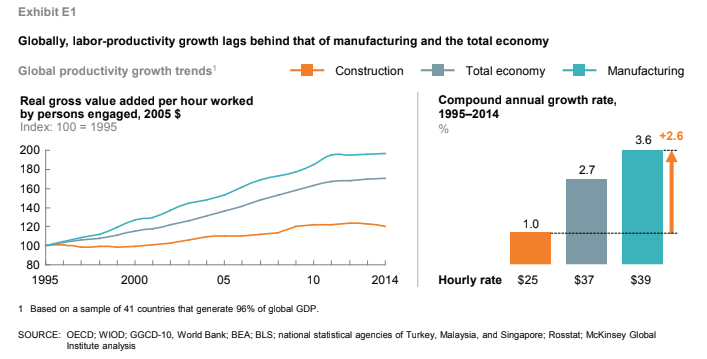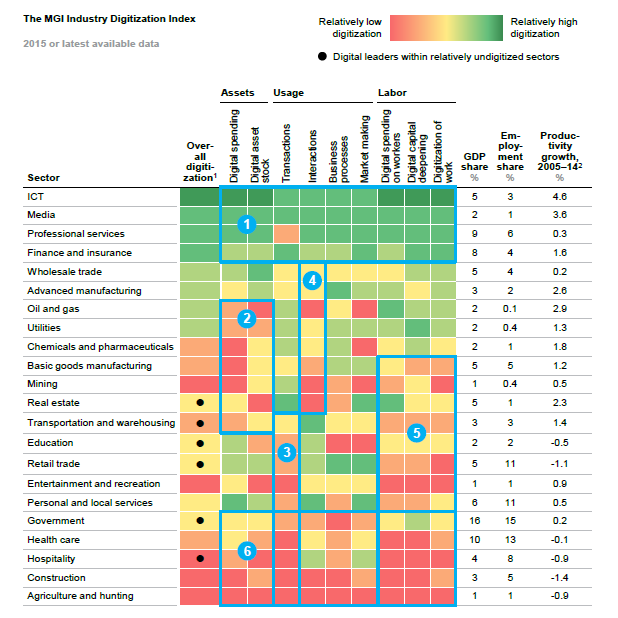Planning construction projects
Damian Bucke, Aphex and Costain Skanska JV, discusses the importance of communication, collaboration and simplicity when planning construction projects.
Contents |
[edit] Introduction
"Plans are nothing; planning is everything” is a famous quote by former US President Dwight D Eisenhower (1890-1969). While some people may question whether plans really are nothing, many more would understand and agree with Eisenhower’s sentiment and his emphasis on the importance of the planning process over the plan itself.
As the graph above demonstrates, over the past number of decades the construction industry’s productivity has been static, with a concerning lack of growth.
This trend, and an increasingly competitive market, has prompted the construction industry to shift its focus on improving productivity, with high-profile initiatives such as ICE’s Project 13 formed to tackle the issue.
The initiatives set out by Project 13 aim to disrupt the industry, boosting certainty and productivity in delivery and improve whole life outcomes in operation.
And as reported in the October 2018 edition of NCE, with the construction industry currently 21% less productive than the rest of the economy, there really is no time to waste.
[edit] The adoption of digital technology
The under-use of digital technology within construction has been widely documented and can be understood as a key reason for lower productivity levels. But in recent years, there's been a surge of innovation in this area with a huge stream of apps and new software options open for companies to explore.
According to McKinsey Global Institute’s Digitisation Index - as seen below - construction is one of the least digitised industries in the world, but for how long.
At a project level, robust short-term planning remains one of the most reliable and effective methods for a project to increase both efficiency and productivity for maximum programme and commercial benefits.
As Eisenhower inferred, simply having plans in place will not solely bring about these improvements, as this relies ultimately upon the quality of the planning within those plans.
Fortunately, there are some reliable methods for ensuring short-term plans are produced with the quality required to improve production.
[edit] Collaboration
On a construction project, collaboration is key. The importance of knowing, and fully understanding, how your planned works will interface with the works of others planning their own works around you cannot be understated.
Not only does effective collaboration prevent needless waste through mitigating the likelihood of two workgroups planning work in the same location at the same time, but more importantly it prevents the need for last-minute site changes, which is often the root cause of many safety incidents.
For some time, the Lean Construction Institute has led the way in developing collaborative processes, and its website offers further valuable tips on improving collaboration on construction sites.
[edit] Remove constraints
Activities will nearly always have constraints of some sort that, unless addressed, will prevent the activity from being achieved.
Design and documentation for safety, environmental, and quality are the most common forms of documentation constraints that could affect the success of an activity if they're not in place prior to commencing the activities.
With construction being the fluid industry that it is, there will always be situations that arise on a project that require urgent changes to documentation, design, or methods of working.
In such instances, amending the documentation as expediently as possible is vital. However, not having this documentation in place for the activities that aren't subject to late change will be down to poor planning.
Maintaining trackers for documentation can help ensure timely production of documentation to prevent delay.
[edit] Learning from failure
Root cause analysis is a technique commonly used in construction, however, it's more often used to determine how health and safety incidents occurred and to ensure reoccurrence is prevented.
Similarly, grouping and analysing failed activities provides project teams with invaluable data that can be used to identify the common reasons that activities are failing to prevent reoccurrence as much as possible to help increase the overall reliability of the plans.
[edit] Keep it simple
For a plan to be effective, people have to be able to follow the plan. Therefore, adding unnecessarily complicated information should be avoided to prevent confusion.
It's also worth remembering that some people who need to be aware of the plan may find the traditional Gantt or bar chart formats confusing, and other formats should be considered.
Other formats that could be considered include visual plans with activities drawn onto site sketches to show the activities planned to occur on a particular day or week.
Visual plans are especially successful for site teams, and this format is strongly recommended in such circumstances.
Another simple format is a daily list of activities, broken down by location, team, discipline, or a mixture of these to suit the project requirements.
Whichever format is adopted, the most important thing is that a plan should always be clear, concise and as simple as it can be.
This article was originally published here on 11 Oct 2018 by ICE. It was written by Damian Bucke, chief product officer at Aphex and senior planner at Costain Skanska JV.
--The Institution of Civil Engineers
[edit] Related articles on Designing Buildings Wiki
Featured articles and news
The benefits of engaging with insulation manufacturers
When considering ground floor constructions.
Lighting Industry endorses Blueprint for Electrification
The Lighting Industry Association fully supports the ECA Blueprint as a timely, urgent call to action.
BSRIA Sentinel Clerk of Works Training Case Study
Strengthening expertise to enhance service delivery with integrated cutting-edge industry knowledge.
Impact report from the Supply Chain Sustainability School
Free sustainability skills, training and support delivered to thousands of UK companies to help cut carbon.
The Building Safety Forum at the Installershow 2025
With speakers confirmed for 24 June as part of Building Safety Week.
The UK’s largest air pollution campaign.
Future Homes Standard, now includes solar, but what else?
Will the new standard, due to in the Autumn, go far enough in terms of performance ?
BSRIA Briefing: Cleaner Air, Better tomorrow
A look back at issues relating to inside and outside air quality, discussed during the BSRIA briefing in 2023.
Restoring Abbotsford's hothouse
Bringing the writer Walter Scott's garden to life.
Reflections on the spending review with CIAT.
Retired firefighter cycles world to raise Grenfell funds
Leaving on 14 June 2025 Stephen will raise money for youth and schools through the Grenfell Foundation.
Key points for construction at a glance with industry reactions.
Functionality, visibility and sustainability
The simpler approach to specification.
Architects, architecture, buildings, and inspiration in film
The close ties between makers and the movies, with our long list of suggested viewing.
SELECT three-point plan for action issued to MSPs
Call for Scottish regulation, green skills and recognition of electrotechnical industry as part of a manifesto for Scottish Parliamentary elections.
UCEM becomes the University of the Built Environment
Major milestone in its 106-year history, follows recent merger with London School of Architecture (LSE).
Professional practical experience for Architects in training
The long process to transform the nature of education and professional practical experience in the Architecture profession following recent reports.
A people-first approach to retrofit
Moving away from the destructive paradigm of fabric-first.
New guide for clients launched at Houses of Parliament
'There has never been a more important time for clients to step up and ...ask the right questions'
The impact of recycled slate tiles
Innovation across the decades.
EPC changes for existing buildings
Changes and their context as the new RdSAP methodology comes into use from 15 June.






























